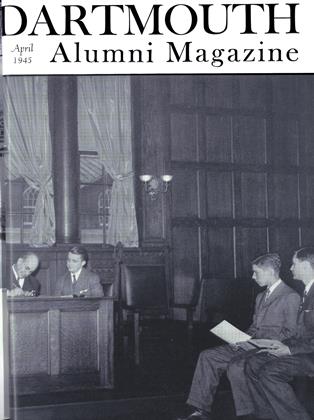Accelerated Schedule and Absence from Court Tournament Create March Lull, Partly Filled by Director's Authorship
I NEED NOT REMIND any of the nostalgic readers of this column (even though their nostalgia may conceivably wear just a little thin when reconstructing Hanover in March and April) that these are the melancholy days, the saddest of the year in the local sports picture. For the past several years, it is true, this melting monotony has been livened by the drama of the Dartmouth basketball team fighting its way into and through the National Collegiate Athletic Association's annual championships, with considerable resultant eclat. Despite the valiant individual efforts of Freshman Ed Leede, who scored a personal total of 230 points (16-point average) during the season, the Big Green is definitely not represented in Madison Square Garden this spring.
What with the usual seasonal decline in sporting activity, plus the unusual absence of Dartmouth from the national basketball picture, the pickings were pretty thin for this month. There was, in short, very little to write about. Imagine the delight of your correspondent when he discovered, in a publication semi-clandestinely published and distributed by one A. I. Dickerson, a long article guest-edited by none other than your erudite Director of Athletics, W. H. McCarter '19. To while away the Ides of March, Bill had retired to his inner sanctum and concocted some very interesting data, which this column immediately wished to give to the wider audience of the entire Dartmouth family—or at least such of it as skims through these efforts. Permission to reprint part of this discussion was graciously granted by the Sage of Memorial Gymnasium, who wanted it very clearly understood, however, that these statistical musings were in no sense a Dartmouth trial balloon for an Ivy League or anything remotely approaching such an organization. So with this already over-long introduction, I give you the Director of Athletics: "We drew up, in the privacy of our den (or sewing room), a hypothetical Ivy League comprised of Columbia, Cornell, Dartmouth, Harvard, Penn, Princeton, and Yale. This we called League A. Then to make it harder, we added Brown for an eight-team League B. Then we kicked out Brown and added Army and Navy, for a nine-team League C. And finally, glutton for punishment that we are, we shot the works with all the above mentioned for a ten-team League D. Having framed all this elaborate pish-posh with four different colored pencils, we drew up ground rules and said that in order to qualify for a league standing a member of League A or B would have to play four league games a season, and a member of League C or D would have to play five. Then with the help of our old friends 'Won, Lost, and Tied" (who have displaced "Unity, Coherence, and Emphasis" on our private pedestal) we tried to find out what was what during the last twenty years. For the first half of this period, nothing was what. Dartmouth and Cornell qualified in League A (the McCoy) seven times apiece, and Yale and Princeton once, but the rest of the boys weren't speaking to enough of each other.
"In 1935 they got hot, and for the next ten years Dartmouth and Cornell qualified ten times each, Princeton and Yale nine each, Penn six, Harvard five, and Columbia two. Penn won the hypothetical league championship (the Guest-Editor Cup) four times, Cornell three times, Dartmouth twice, and Princeton once, thus proving that Crisler, Blaik, Snavely, and Munger all work well with stuff. If you want to branch out to the more elaborate Leagues B, C, and D, go ahead. We don't. Penn wins them all with four seasons each, and Dartmouth ties Cornell for second place (two seasons) in League B, ties Navy for second (two seasons) in League C, and gets a clean second with three good seasons in League D. The original computations, you'll be glad to hear, are to be shown only to our most intimate friends."
 View Full Issue
View Full Issue
More From This Issue
-
 Article
ArticleRADIO WAVES AND RADAR
April 1945 By GORDON FERRIE HULL JR. '33, -
 Lettter from the Editor
Lettter from the Editor'Round the Girdled Earth
April 1945 By H. F. W. -
 Article
ArticleLaureled Sons of Dartmouth
April 1945 By H. F. W. -
 Class Notes
Class Notes1918
April 1945 By ERNEST H. EARLEY, DONALD L. BARR -
 Class Notes
Class Notes1945
April 1945 By ARTHUR NICHOLS -
 Article
ArticleMedical School
April 1945
Feancis E. Merrill '26
Sports
-
 Sports
SportsTWO DARTMOUTH MEN WITH OLYMPIC TEAM
August 1924 -
 Sports
SportsFRESHMAN BASKETBALL
APRIL 1928 -
 Sports
SportsAssets for 1948
October 1948 -
 Sports
SportsTRACK
June 1948 By Francis E.Merrill '26 -
 Sports
Sports'45 Football
December 1941 By Frank Hall '41 -
 Sports
SportsThe Legend of the Clinging Vine
Jan/Feb 2002 By Mark F. Bernstein



